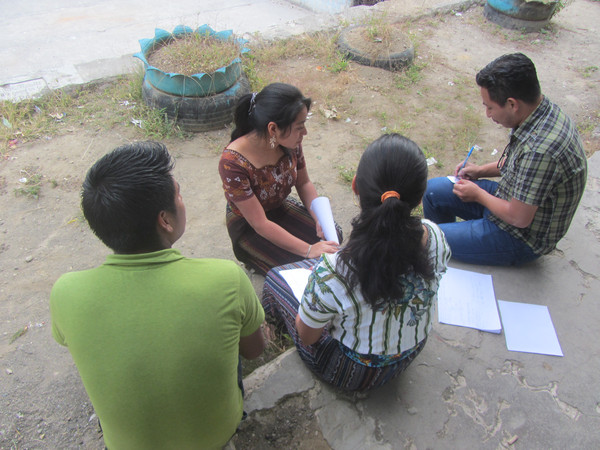The Power of a School
Teen parenthood, poor health, malnutrition and poverty are all a part of life in San Antonio Chacaya, where, traditionally education ended in 5th grade. This changed in 2008 with the founding of a (three year) half-day middle school named Instituto Educación Básica por Cooperativa de San Antonio Chacaya.

I sat down with the Head Teacher, Mariano, and invited him to talk about his project – its origins, growth, and struggles:
In its first year, the school welcomed 16 students. Enrollment has since tripled, but there are still many empty seats. Most children in the community do not sign up – impeded by the lack of resources to pay the meager student fees or the pressure to work. Generation after generation has lived without a school, and has accepted that as a part of life. So Mariano recognizes that the community does not see education as an option for them and wants to change that. Mariano and his teachers want the community to see the true potential of its children and for the children to see the potential within themselves. They want to “see a town more developed than it was when they began” and to “help students learn what they need to get out of the extreme poverty in which they live.”

The school receives about $133 from the government per month, and another $80 from the municipality. The rest of the school’s operational costs are gathered through student fees (about $5.5 per child per month). The Mariano walked me through a little matmajority of this money is divided up among the teachers, who receive $33 per month for personal transportation, classroom materials, and salary.
If we begin with $33 and subtract $24 for personal transportation (the teachers don’t own cars, so they pay $1 round-trip to hop on a public “pick-up”), this leaves $9 for classroom materials essential to learning. What’s left over? Nothing. So when all is said and done, the teachers are volunteers. Some day Mariano hopes to be able to pay them what they deserve. This is just one of the goals that JUSTA would like to help them reach.
JUSTA has been working closely with the school since 2013.
Over the years we’ve implemented a variety of short-term projects with the school: nutrition workshops, permaculture and eco-building events, yoga and meditation classes, and a student scholarship program.
At the end of the past school year (in October), our fantastic Chacaya Program Coordinator, Stéphanie Desruelles, worked with Mariano to identify a long-term approach for the 2016 school year (beginning this month). They identified three areas of focus:
- student support: scholarships to help students continue their education and to possibly enroll more students into school
- teacher support: professional development through a variety of teacher training sessions and an attempt to move away from traditional teaching methods to a more participative and motivational student-centred approach
- health and wellness for all: regular yoga/meditation/nutritional classes and a series of day clinics with qualified doctors
2016 is off to a great start!
With school starting again, we’ve been fundraising for scholarships and beginning the first step of our professional development for teachers. JUSTA organized a three-part workshop series to take place during the two weeks leading up to the 2016 school year. The workshop series was designed to create a foundation on which to build more dynamic and creative classrooms that truly meet the needs of the children.
 The first workshop was led by Rudy Antonelly Gómez Sánchez (clinical psychologist, meditation and yoga teacher). He provided an overview of human development (physical, social, sexual, and spiritual) with a focus on the adolescent period and the needs of adolescents. Teachers led passionate conversations about how to best support adolescents in poverty or in unstable families using an understanding of their developmental stage.
The first workshop was led by Rudy Antonelly Gómez Sánchez (clinical psychologist, meditation and yoga teacher). He provided an overview of human development (physical, social, sexual, and spiritual) with a focus on the adolescent period and the needs of adolescents. Teachers led passionate conversations about how to best support adolescents in poverty or in unstable families using an understanding of their developmental stage.
 Clinical psychologist and certified Montessori guide, Shirley Yancor López, led the second workshop. In October, JUSTA arranged for the Chacaya teachers to visit Shirley’s Montessori school in Xela, observe her method and classroom environment and provide a foundation for this January workshop. Shirley expanded on their observations by detailing 10 key elements of a Montessori classroom (motivation, student-centered approach, participation, independence, creativity, etc.) and working with teachers to imagine ways for those elements to be incorporated into their mainstream school.
Clinical psychologist and certified Montessori guide, Shirley Yancor López, led the second workshop. In October, JUSTA arranged for the Chacaya teachers to visit Shirley’s Montessori school in Xela, observe her method and classroom environment and provide a foundation for this January workshop. Shirley expanded on their observations by detailing 10 key elements of a Montessori classroom (motivation, student-centered approach, participation, independence, creativity, etc.) and working with teachers to imagine ways for those elements to be incorporated into their mainstream school.
 The final workshop of this series was lead by Zachary Towne-Smith of Caracol Consulting. Teachers explored practical strategies to embed creativity, motivational, and hands-on activities into their classrooms. They found particularly effective the idea of having students clearly state their learning goals in order to establish a shared list as well as a group commitment to what they will invest in order to reach those goals. The central activity was a role-play showing the challenges they face in the classroom, acting out a negative teacher response followed by a response that embodies the values they’ve identified to be ideal during the previous two sessions.
The final workshop of this series was lead by Zachary Towne-Smith of Caracol Consulting. Teachers explored practical strategies to embed creativity, motivational, and hands-on activities into their classrooms. They found particularly effective the idea of having students clearly state their learning goals in order to establish a shared list as well as a group commitment to what they will invest in order to reach those goals. The central activity was a role-play showing the challenges they face in the classroom, acting out a negative teacher response followed by a response that embodies the values they’ve identified to be ideal during the previous two sessions.
These sessions required a great deal of energy, time, and bravery, but as evidenced by their commitment to work late and forego breaks, they are highly motivated to do everything they can to give their students what they deserve. They understand that our future, and our present depend on them. A few teachers even invited family members interested in education to come and take advantage of the opportunity. Reflections and surveys following these workshops indicate that teachers want to continue working with these themes and developing their skills, so we’re working with Mariano to plan the next steps and we’ll continue to respond to their enthusiasm throughout the year.

With this workshop series, the Instituto’s team of dedicated teachers is expanding and further defining the power of their school. Schools in and of themselves are not necessarily agents of change, but good school are powerful, and may be the key to easing poverty in Chacaya. By founding the Instituto in 2008, Mariano and the teachers created a framework for their work in the community. Now, by shifting the focus to the learners’ needs, expanding opportunities for choice and creativity, and taking a holistic approach to education, the teachers are beginning to answer the question of how to make their impact.
Make your impact with JUSTA
JUSTA not only provides resources for the middle school, but also supports the individual, at-risk students through our scholarship program. These students come from families without the financial means to afford the $85 yearly expense for tuition, school supplies, and uniform. We need your help to secure the last 15 scholarships for our students. Invest in a child’s education and change a life forever by donating here!
By Jackie Mauer, JUSTA Programs Director

